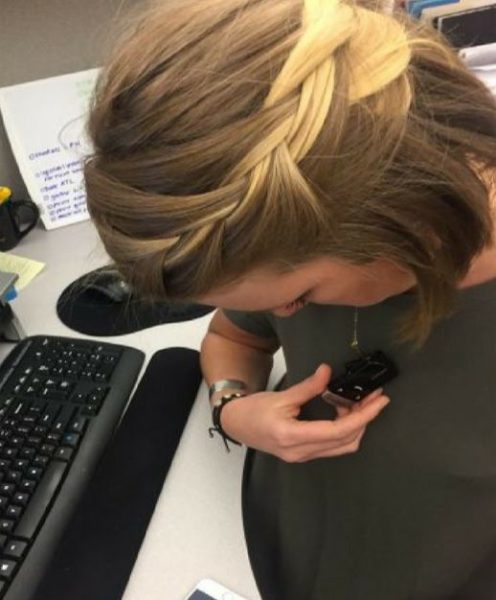Adapting to new ways of connecting during the pandemic can be a challenge. Bec offers tips on how to make the most of video chat with a cochlear implant.
“I was recently invited to a group video hangout. In that one hour, I not only learned a lot about the video platform, but more importantly, what a difference it makes to feel a part of a caring, supportive group of people – even if I didn’t hear everything,” said Bec. Bec is a cochlear implant recipient, blog writer and coordinator for Hear For You, a support group for teenagers with hearing loss, in Sydney, Australia. Feeling a bit isolated and looking to reconnect, she decided to try video chat. See her suggestions for optimizing video chat with cochlear implant:
A new way of staying connected
“As friends, family and other community groups move to virtual chat rooms and video conferencing to stay connected, it’s easy for those of us with hearing loss to get left behind. A lot of groups are turning to virtual platforms. I knew I would only be able to hear a portion of everything said, but I decided I should give it a go to see if I can still benefit from being a part of the community. Live captions for many will be the gold standard of access, but if live captions aren’t an option, here are some tips that I learned for you to share with others who don’t have a hearing loss to make virtual meetings easier for you.”
1. Use a microphone
“Hearing loss isn’t just about volume, it’s also about clarity. A person with good hearing can often push through background noise, static or echo and understand the speaker, but it’s a bit harder to participate on video chat with cochlear implant.
Ask your friends to use a personal microphone close to their face. This can really improve the sound quality. They simply need a pair of earphones with a microphone that they would normally use with their mobile phone. Any kind of lapel microphone worn on the collar can also work.”
2. Press mute
“It’s sometimes impossible to avoid background noise when on a call, especially if anyone on the call has kids or a loud air conditioner in the background. In a group video chat, the amount of background noise can be reduced by asking everyone who isn’t speaking to press mute. It means only one microphone is on at a time.”
3. Use ‘Active Speaker’ mode
“If you have hearing loss, ‘Active Speaker’ mode automatically switches the large video onto whoever is speaking. That means you can see a larger image of the person who is speaking while everyone else appears in small icons at the top of the screen. This makes it easier to lip read. Make sure your group knows about the different modes (you can learn more about them on the Zoom website).”
4. Think about lighting
“Many people with hearing loss rely on lip reading to communicate, but that’s really hard if the faces of people on the call are in a shadow. Ask everyone to adjust their chair so that their faces are well lit and that their whole face is in the frame.”
5. Use the ‘Chat’ function
“Even in the best circumstances, sometimes there is a word that I just can’t understand. The word could be repeated 100 times, but it won’t make a difference – I just can’t hear the sound. Let others on the call know that if they are repeating a word or sentence more than two or three times, it will help you if they jump in and type it in the live chat function.”
6. Don’t rush
“Most people with hearing loss take a little longer than everyone else to process what they hear, and it can be hard to keep up in a group conversation. Ask everyone to slow down and take their time when talking and to avoid changing topics quickly.”
7. Use the extra functions
“In the virtual platform, there is a ‘Raise Hand’ function where anyone can click a button to raise their hand if they have something to contribute. Also, turning on non-verbal feedback through the settings unlocks extra buttons like ‘Go Slower’ and lets participants remind everyone to slow down. Using functions like these stops people from talking over the top of each other so everyone has a chance to be heard.”
8. Decide on a facilitator
“Nominate someone to lead or facilitate the meeting or chat. This person can rotate, but they are the one keeping an eye out for any ‘raised hands’, making sure everyone has their say. It may seem formal and awkward at first but having one person responsible for leading the chat means anyone who is struggling is not left behind. After a while, having a facilitator no longer feels awkward.”
9. Checking in on people who are hearing impaired
“Remind your friends who don’t have a hearing loss to follow up and check on anyone on a call who does – especially after a group virtual hangout. Sometimes, people with a hearing loss can be left feeling more isolated than before if they haven’t been able to follow the conversation. Ask them if there is anything else you can do to keep them included; everyone has their own tips to making different forms of communication work.”
10. A final piece of advice
“These meetings won’t be perfect. They will be hard, and you’ll probably struggle at times. Being prepared for that makes it easier to cope with. When I approached that group chat, I had the attitude that I didn’t have to catch everything. If I missed 25% of what was said but could still follow roughly what was happening, that’s okay. You also won’t know how well you will cope until you try, so give it a go with some safe and patient friends. It won’t work for everyone. At times, I haven’t been able to hear anything in face-to-face group chats, let alone online video chats, but give it a try just once. See how you go and if it doesn’t work for you don’t be afraid to say so.”
Following Bec’s advice for a successful video chat with a cochlear implant is a strong first step in adjusting to a new way of communicating with your friends and family.
There may be times where virtual activities can be more challenging than others. Consider Cochlear’s True Wireless™ accessories in these situations. With our True Wireless™ accessories, you can stream sound directly to your sound processor using built-in 2.4 GHz wireless protocol that Bluetooth®1 and Wi-Fi devices depend on.
Learn more about True Wireless™ accessories and how they can help you hear better in challenging situations.
- The Bluetooth® word mark and logos are registered trademarks owned by Bluetooth SIG, Inc. and any use of such marks by Cochlear is under license.

